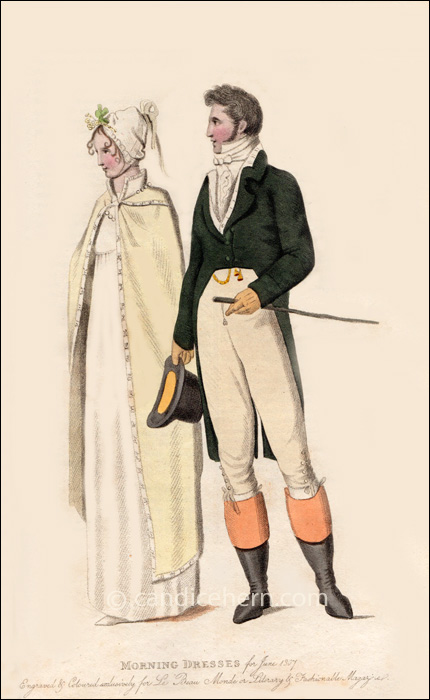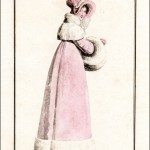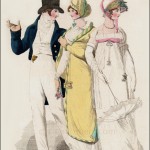Le Beau Monde, June 1807.
“Morning Dresses for June 1807”
The lady’s dress is called in the description a Barouche Dress. As the barouche was sort of a town vehicle, typically driven with the hood down, I do not think the lady’s costume would be considered a Carriage Dress, which implies longer travel in an enclosed vehicle. I suspect a Morning Walking Dress and a Barouche Dress would serve the same purpose, that is, to be seen in public, beautifully dressed.
The lady’s outer garment is described as a mantelet. I’ve only seen that term used for a short cloak. A cloak of this length is most often simply called a mantle.
The print is described in the magazine as follows:
“A BAROUCHE DRESS.–A compleat shell of thin muslin, worn over a white sarsnet slip, made quite short, open behind, and tied with small cords and tassels down the back; the muslin dress is made to the size of the throat, and the sarsnet slip, with a high standing collar, trimmed round the edge with a French lace; long sleeves of white sarsnet, and short full muslin sleeves worn over the sarsnet. Long square mantelet of primrose silk, embroidered with a dark rich border of embossed ribband; the two ends are tied with a knot on the front of the bosom; a rich lace cap line with the same colour as the mantelet, made with a point, and worn very deep on the left side of the face, and exposes the whole of the right. A small bunch of primroses is fixed on the center of the cap; long streamers of primrose satin ribband at the top of the crown. The front of the cap is trimmed with puffings of lace. Primrose gloves and shoes.
“(The above dresses were invented by Miss Heffey, of Pall Mall.)”
After General Observations of Ladies Dresses, the dress of the gentleman is described, along with suggestions of alternative styles or fabrics:
“MORNING DRESS FOR GENTLMEN.–A mixed coat, single breasted, cut off the front, and made of light greenish mixture, or pepper and salt kind, with covered or plated buttons, and collars of the same cloth; the skirts rather shorter than the dress costs, and the pockets in plaits behind.–Waistcoats of printed quilting, made single-breasted, of dark brown or olive stripes, as also the gold coloured stripe, shaded with black, are most prevalent, and are made without any bindings.–Lightish drab kerseymere, or stocking pantaloons, with Hessian boots; ribbed kerseymere pantaloons are still worn; as also drab kerseymere breeches with gilt buttons and brown top boots. Nankeen pantaloons and trousers are becoming very prevalent, and are frequently attended by nankeen gaiters.”








